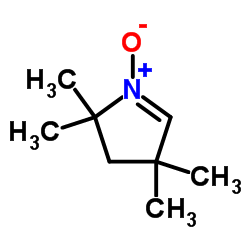Use of M4PO and oxygen-17 in the study on hydroxyl radical generation in the hypoxanthine-xanthine oxidase reaction.
H Mori, T Arai, K Mori, H Tsutsui, K Makino
Index: Biochem. Mol. Biol. Int. 32(3) , 523-9, (1994)
Full Text: HTML
Abstract
To determine whether hydroxyl radicals (.OH) are generated in the hypoxanthine (HPX)-xanthine oxidase (XOD) reaction, we examined the electron paramagnetic resonance (EPR) spectra of the spin adducts formed. In the EPR study, we used 3,3,5,5-tetramethyl-1-pyrroline-N-oxide (M4PO) as a spin trap, sodium formate (HCOONa) as a .OH scavenger, and oxygen-17 gas as an oxygen source. In the HPX-XOD reaction, both M4PO-OOH and M4PO-OH were observed in the reaction products. The formation of M4PO-OH was independently inhibited by HCOONa resulting in the formation of M4PO-CO2- and in no effects on the formation of M4PO-OOH. With oxygen-17 gas as an oxygen source in the HPX-XOD reaction, both M4PO-17OOH and M4PO-17OH were observed in the reaction products. These results indicate that M4PO-OH is not produced by decomposition of M4PO-OOH and .OH is actually generated during the HPX-XOD reaction.
Related Compounds
| Structure | Name/CAS No. | Molecular Formula | Articles |
|---|---|---|---|
 |
3,3,5,5-tetramethyl-1-pyrroline n-oxide
CAS:10135-38-3 |
C8H15NO |
|
Use of 3,3,5,5-tetramethyl-1-pyrroline-1-oxide spin trap for...
1989-11-15 [Biochem. Biophys. Res. Commun. 164(3) , 1274-80, (1989)] |
|
The effect of myoglobin on the stability of the hydroxyl-rad...
1994-05-01 [Free Radic. Res. 20(5) , 327-32, (1994)] |
|
Oxidation of spin-traps by chlorine dioxide (ClO2) radical i...
1996-01-01 [Free Radic. Biol. Med. 20(6) , 837-41, (1996)] |
|
Spectral editing based on selective excitation and Lee-Goldb...
2006-06-01 [Solid State Nucl. Magn. Reson. 29(4) , 272-7, (2006)] |
|
Biological spin trapping. II. Toxicity of nitrone spin traps...
1995-11-01 [J. Biochem. Biophys. Methods 30 , 239-247, (1995)] |